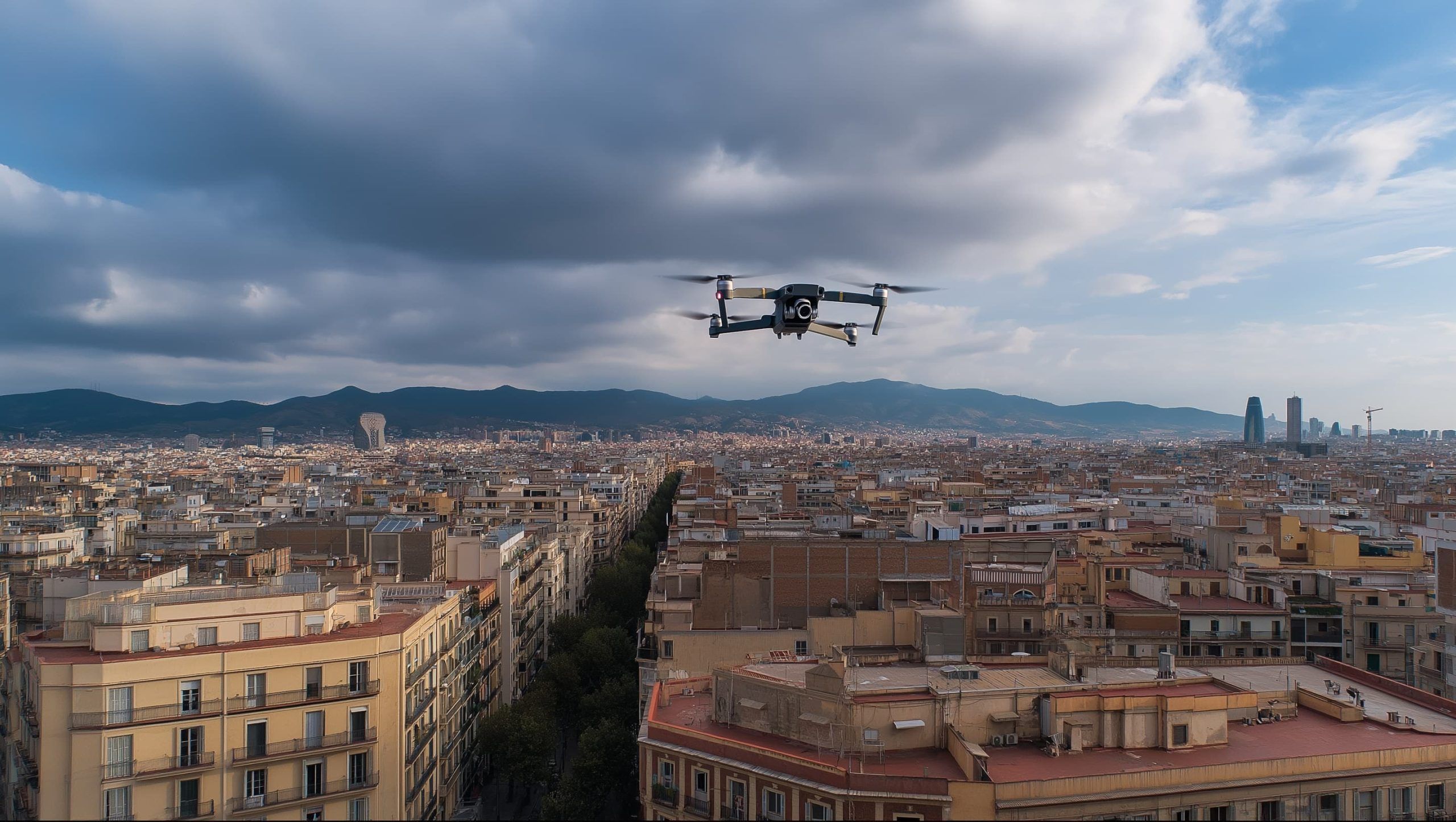- Royal Decree 517/2024, enacted June 25, 2024, overhauled Spain’s drone laws to fully align with the EU and introduced an Interior Ministry urban-flight notification, while operator registrations now last 3 years.
- Urban-flight notification requires informing the Interior Ministry at least 5 days before any flight in an urban area such as Barcelona.
- The Geographical Zones system replaced the old 8 km airport rule, with the ENAIRE map showing red and yellow CTR areas around El Prat that require ATC clearance for flights.
- AESA operator registration is mandatory for any drone 250g+ or with a camera, yielding a visible Operator ID to mark on the drone, with online registration available for foreigners.
- Basic A1/A3 certificate is required for drones ≥250g or operations outside the Open category, while an A2 certificate is required for drones up to 2–4 kg to operate closer to people.
- Specific Category operations require Level 3 training (STS) and AESA authorization, with risk assessments (SORA) and case-by-case permissions.
- Insurance is effectively mandatory for commercial drone operations, with third-party liability typically €220,000–€750,000 and exemptions for Open category drones under 20 kg.
- In Barcelona’s central areas, casual flights are largely prohibited due to CTR and crowds; pilots must maintain visual line of sight and fly only during daylight.
- No-fly zones include El Prat CTR, heliports, ports, hospitals, military/government sites, nature reserves such as Collserola, and UNESCO monuments like Sagrada Família and Park Güell, which require permits for commercial flights.
- National AESA rules apply country-wide, while Barcelona’s City Council, Mossos d’Esquadra, and Guardia Urbana can require local permits for take-off/landing and enforce privacy, with RD 517/2024 promoting coordination.
Barcelona is a stunning city – but if you plan to fly a drone there in 2025, you’ll face some of the strictest regulations in Europe. Recent law changes have overhauled drone rules in Spain, affecting everything from casual vacation flights to professional aerial filming. This comprehensive guide breaks down recreational vs. commercial drone use, the permits, licenses, and registrations you’ll need, when and where you can fly (spoiler: much of Barcelona is off-limits without special permission), the penalties for breaking the rules, how local Catalan regulations interact with national law, and the latest updates (2024–2025) that every drone pilot should know. We also include links to official sources (AESA – Spain’s aviation authority) for reference.
Recreational Drone Use in Barcelona (Residents & Tourists)
Flying a drone for fun in Barcelona is heavily regulated. Spain’s drone laws (which align with EU-wide rules) no longer distinguish between “recreational” and “commercial” use in terms of airspace rules – instead, rules depend on the risk category of the flight [1]. However, as a recreational pilot you must follow the same safety rules as professionals, and Barcelona’s urban environment makes hobby flying very challenging:
- Operator Registration: If your drone weighs 250g or more, or it has a camera (nearly all camera drones, even under 250g), you must register as a UAS operator with AESA (Spain’s aviation safety agency) [2] [3]. Registration is free and online, and you’ll receive an operator ID that must be visibly marked on your drone [4] [5]. Example: A tourist with a DJI Mini (249g, with camera) must register and label their drone before flying in Spain [6]. (If you’re already registered in another EU country, that registration is valid – do not register twice, just mark your drone with your existing EU operator ID [7].)
- No License Needed for Small Hobby Drones:Pilots of lightweight drones (<250g) do not need a formal license or training certificate for basic recreational flights [8]. You’re only required to read and understand the user manual. That said, for drones ≥250g, you must pass an online theory exam (AESA’s “Nivel 1” test for A1/A3 category) to get a basic pilot competency certificate [9] [10]. In practice, even if flying a sub-250g drone, it’s highly recommended to study the rules. (Note: Age limits – the minimum age for a drone pilot in Spain is generally 16 years, though it can be lower (14 or 12) for very small drones under adult supervision [11].)
- Where Can You Fly?Almost nowhere inside central Barcelona. The city is covered by restricted airspace due to the international airport (El Prat) and dense urban population. All of Barcelona lies within a controlled airspace (CTR) zone where unauthorized drone flights are forbidden [12] [13]. The official ENAIRE drone map shows Barcelona blanketed in red and yellow zones (no-fly and restricted zones) for kilometers beyond the city limits [14]. In practical terms, a hobbyist cannot take off anywhere in Barcelona’s city center or near landmarks without special permission. Even parks, beaches, and tourist sites are off-limits if other people are around or if the area is restricted (which most of Barcelona is). The only feasible places to fly recreationally are well outside the city – you may need to drive 30–50 km away to find unrestricted areas [15] [16]. Local drone clubs and model aircraft fields in the suburbs (e.g. Sant Cugat or Montcada) are the safest options for hobby flying [17].
- Altitude and Distance Limits: Spain follows EU rules: maximum altitude 120 meters (400 ft) above ground [18], and you must keep the drone within visual line-of-sight (VLOS) at all times [19]. Flying over gatherings of people is strictly prohibited – even with a tiny drone, you should avoid flying directly over anyone not involved in the flight [20]. In Barcelona this essentially means you cannot fly over busy tourist spots or crowds under any circumstance. Keep a safe distance from people and private property to respect privacy and avoid “nuisance” complaints (Spain’s data protection laws prohibit filming people without consent) [21] [22].
- Time of Day: Night flying is not allowed in the basic “open” category. As a recreational pilot, you can only fly in daylight (or civil twilight with lights on the drone) unless you obtain a special authorization for night operations [23]. Given Barcelona’s restrictions, night flight in the city is essentially a non-starter for hobbyists.
- Tourist Considerations: For foreign visitors, the Spanish rules apply equally. If you come from outside the EU, you should register with AESA as a foreign operator (AESA provides an online process for foreigners using your passport) [24] [25]. EU residents visiting Spain can fly under their home-country registration and certificates [26] [27]. Always travel with proof of your registration and any competency certificates. Also, be mindful that popular sites like the Sagrada Família, Park Güell, beaches, and central Barcelona are all in no-fly zones without special permits [28] [29]. Spanish police (including local Barcelona police and the Mossos d’Esquadra) are known to stop and fine errant tourist pilots, even confiscating drones in some cases. In short: recreational drone flying in Barcelona is heavily restricted – when in doubt, don’t take off.
Commercial Drone Use in Barcelona (Business & Professional)
Using drones for business or professional purposes (aerial photography, filming, inspections, etc.) in Barcelona comes with additional layers of regulation. While the baseline flight rules (airspace, altitude, etc.) are the same, commercial operators are generally expected to meet higher standards in training, certification, and permission. Key points include:
- Pilot Certification: For any commercial drone operations, the remote pilot must have the appropriate EU drone certificate for the category of operation. In practice, most professional uses that go beyond basic hobby flying will fall under:
- Open Category A2 (for flights closer to people using <4kg drones) – requires the AESA A2 theory certificate (on top of A1/A3) [30].
- Specific Category (for riskier operations like flying over people, at night, in controlled airspace, or beyond visual line of sight) – requires advanced training (Level 3 theory, possibly practical exam) and an operational authorization from AESA [31]. Many commercial projects in Barcelona (e.g. filming in the city) end up in the Specific category, which means the operator must perform a risk assessment (SORA) and apply to AESA for permission for that specific flight or use a pre-approved scenario.
- In short, a professional drone pilot in Spain needs more than the basic hobby certificate. They should be fully licensed for the scenarios they intend to conduct, and carry proof of their certifications at all times [32] [33].
- Insurance:Liability insurance is effectively mandatory for commercial drone operations in Spain. Spain historically required all drone flights to be insured, and although the new 2024 law introduced some exemptions for hobbyists (Open category A1/A3 flights) [34] [35], commercial flights (A2 subcategory and Specific category) are still required by law to have insurance coverage [36] [37]. Professional operators must carry a third-party liability policy – typically with coverage on the order of €220,000 to €750,000 or more, depending on drone weight and operation type [38] [39]. For example, Barcelona’s city permit process for filming near monuments requires proof of at least €300,000 in liability coverage [40]. In short, if you’re doing business with your drone, get insured and be ready to show a Certificate of Insurance.
- Operational Authorizations & Permits: Flying a drone for work in an urban area like Barcelona requires multiple approvals:
- AESA Authorization: If your operation is outside the standard Open category rules (for instance, filming downtown, over people, or in controlled airspace), you need to seek authorization from AESA. This involves submitting an operation plan or risk assessment. Spain now uses the EASA “Standard Scenarios” (STS) for common operations – as of 2024, Spanish authorities have phased out their old national scenarios and fully transitioned to EU standard scenarios for easier cross-border recognition [41] [42]. If you’re a Spanish operator with any remaining national scenario declarations, note that after August 2024 you can’t make new ones and must switch to EU standards [43] [44].
- Barcelona City Permit: For any commercial filming or photography in Barcelona’s city limits, you generally need a permit from local authorities. The Barcelona City Council (Ajuntament) often requires drone filming to go through the Barcelona Film Commission or Department of Architecture & Heritage for approval [45] [46]. This usually means applying weeks in advance, detailing your flight plan (location, time, altitude), showing proof of pilot credentials and insurance, and getting consent to take off/land on city property. For example, to film near La Sagrada Familia, you must apply at least 15 days ahead to the City Council with all documentation, and you will only be approved for commercial (not recreational) purposes [47] [48].
- Special Local Authorizations: Certain areas have their own authorities. Port of Barcelona property requires permission from the Port Authority in addition to ENAIRE’s airspace clearance [49] [50]. If flying near a heliport (e.g. the downtown heliport), you need clearance from that heliport as well [51]. Essentially, a professional must coordinate with all relevant entities: AESA for air safety, Interior Ministry (for security notifications), local government (for land use permits), and air traffic control if near the airport or heliports.
- Flying in Controlled Airspace: Much of Barcelona lies in controlled airspace due to El Prat Airport (LEBL). To operate in controlled airspace (CTR), a special ATC authorization is needed on top of AESA’s permission. Drone pilots must have additional training (e.g. a radio operator’s certificate) to communicate with air traffic control if required [52]. In practice, only experienced, certified operators with explicit ATC clearance can fly in Barcelona’s CTR, and usually only for approved projects. The 8-km airport exclusion that existed under older laws has been replaced by these case-by-case controlled airspace authorizations and altitude limitations in the official map [53] [54].
- Privacy and Data Laws: Commercial drone users must be mindful of Spain’s privacy laws (the GDPR and Spanish Organic Law on Data Protection). Filming people without consent, especially for commercial use, can lead to legal trouble [55]. Always obtain releases if filming identifiable individuals or private property for a project. Barcelona’s authorities take privacy seriously – unauthorized drone filming can result in your footage or drone being confiscated by police if complaints are raised.
Bottom line for professionals: To fly a drone in Barcelona for business, you must be a properly registered operator, have a licensed pilot with the correct EU certificates, insured operations, and secure all necessary authorizations (from AESA, local authorities, and possibly ATC). It’s a multi-step process, and flying first, asking forgiveness later is not an option – the fines and risk of shutdown are too high, as we’ll see below.
Required Permits, Licenses, and Registrations
All drone pilots in Barcelona (and Spain generally) must navigate a few bureaucratic steps before taking off. Here’s a breakdown of the key permits, licenses, and registrations required, and who needs what:
- Operator Registration (AESA):Mandatory for almost everyone. As noted, any person or business operating a drone with 250g+ weight or a camera must register as a drone operator with AESA [56] [57]. This yields an Operator ID that you must mark on all your drones [58] [59]. The only exception is if you fly a <250g drone with no camera (and not a modified toy) – a very rare case. Registration is done online through AESA’s website (with a digital certificate or via a special process for foreigners) [60] [61]. Tip: Once registered, print or engrave your Operator ID on a durable label and attach it to your drone (Spanish rules used to require fireproof plates with name and address, but under EU rules only the Operator ID number is required now [62]).
- Remote Pilot License/Certificate: Spain doesn’t issue a “pilot license” per se for drones, but pilot competency certificates are required for certain drone categories:
- Basic A1/A3 Certificate: Needed for any drone ≥250g, or for any operations outside the lowest risk category. This is obtained by passing AESA’s online theory exam (free, ~40 questions on drone safety) [63]. If you have a certificate from another EASA country, Spain will recognize it [64]. Recreational pilots with sub-250g drones do not need this certificate by law, but getting it is recommended to ensure you know the rules [65] [66].
- A2 Certificate: Required if you want to fly a larger drone (up to 2–4kg) in somewhat closer proximity to people than A3 allows (for example, real estate filming in suburban areas). This involves additional self-practical training and a second exam through AESA [67]. Many serious hobbyists and most commercial pilots obtain the A2 cert to expand where they can fly.
- Specific Category Training: If your operation doesn’t fit in the Open category (e.g. drone deliveries, crowd filming, etc.), you need advanced training (Level 3, STS, or LUC certification). This often means taking an accredited course and/or test. Spain’s new drone law created a framework for UAS pilot instructors and examiners, meaning there are now authorized schools where you can get training for advanced operations [68] [69].
- Drone Registration (Interior Ministry): A new twist in 2024 – Spain now requires registering the drone itself with the Ministry of Interior for certain cases [70]. This is separate from AESA operator registration. It appears aimed at creating a database of drones for security purposes (handled by law enforcement). Article 40 of the new Royal Decree also ties into this, as discussed below in urban flight notifications. Implementation is ongoing: as of early 2025, authorities were still streamlining how hobbyists should submit these notifications/registrations for individual flights [71] [72]. Keep an eye on AESA’s website for the exact procedure – but be prepared to fill out additional forms or online notices with your drone’s details and your flight plan when flying in sensitive areas.
- Interior Ministry Notification (for City Flights):Crucial for Barcelona: Under the 2024 law, any flight in an “urban environment” requires prior notification to the Ministry of Interior [73]. This applies to all pilots (including recreational) if flying in town. Practically, if you intend to fly within Barcelona or any populated area, you must email or submit a form to the Interior Ministry (often via the local police, e.g. Mossos d’Esquadra in Catalonia) with details of your planned flight at least 5 days in advance [74] [75]. The notification typically needs your operator info, pilot info, drone specs, location, date, time, and purpose of flight. Even a tourist with a 249g drone is technically required to do this before flying in Barcelona [76] [77]. This new requirement was introduced to help police differentiate legitimate drone operations from illegal ones in cities [78]. Failing to notify makes your flight illegal, even if you follow all other rules.
- Other Permits: Depending on location and purpose:
- Landowner Permission: Always secure permission for your take-off/landing site. For public land in Barcelona (parks, streets), the city may have rules against drone launches without a permit [79] [80]. For private property, get the owner’s consent.
- Event/Specific Zone Permits: Temporary no-fly zones can pop up during events. Barcelona hosted the America’s Cup 2024 and enforced a drone ban over the waterfront during events [81]. Always check NOTAMs and the ENAIRE map for “particular UAS zones” that local authorities might establish [82]. If you need to fly in such an area, you’d require a special permission (usually hard to get).
- Environmental Permits: Barcelona is near the Collserola natural park and coastline. Nature reserves and national parks require special authorization from park authorities or AESA [83]. Do not fly in designated protected areas without clearance.
Below is a summary table of who needs which approvals:
| Drone Operation | AESA Operator Registration | Pilot Certificate | Insurance | Interior Ministry Notice |
|---|---|---|---|---|
| Recreational – Drone <250g (with camera) | Yes (mark ID on drone) [84] | Not required (read manual) [85] | Not legally required (A1 category) [86] [87], but recommended | Yes, if in urban area (e.g. Barcelona city) [88] [89] |
| Recreational – Drone ≥250g | Yes (before any flight) [90] | Yes – A1/A3 basic certificate [91] | Not required in A1/A3 if <20kg [92] [93] (still recommended) | Yes, if in urban area (towns/cities) [94] [95] |
| Commercial – Open Category (A2 scenario) | Yes (as business or individual) | Yes – A2 cert (and A1/A3) [96] | Yes – mandatory (A2 not exempt) [97] [98] | Yes, if in urban area (plus any local filming permit) |
| Commercial – Specific Category | Yes | Yes – Level 3/STS training [99] | Yes – mandatory (Specific category) [100] [101] | Yes (if urban) + case-by-case AESA authorization for operation |
Table: Key permit and license requirements for different drone use cases in Spain/Barcelona. All operators must follow EU rules, but Spain adds an urban flight notification requirement. Always double-check current AESA guidelines for any changes.
Rules on Where and When You Can Fly (Airspace & Location Restrictions)
One of the most complex aspects of Barcelona drone laws is figuring out where you’re allowed to fly. Spain has implemented detailed “UAS Geographical Zones” that designate restricted areas, no-fly zones, and altitude limits across the country [102] [103]. Barcelona, being a major city with an international airport and many sensitive sites, is surrounded by such restrictions. Here’s what you need to know:
- Controlled Airspace (Airport – CTR): Barcelona is only ~12 km from El Prat Airport. The airport’s control zone covers most of the city, especially the coastal half. In these areas, drone flights are prohibited without explicit air traffic control permission [104]. The old rule of thumb was to stay 8 km away from airports [105], but now it’s more nuanced: consult ENAIRE’s map for exact boundaries. Essentially, from central Barcelona extending north along the coast and west around the airport, you’re in a red zone. If you need to fly within this, you must coordinate with Enaire/ATC – which only happens for professional operations with clearance. Recreational flyers cannot get this clearance, so for them the CTR is absolute no-fly.
- Urban “Congested Area” Restrictions:Flying over any populated area (even a small town or city neighborhood) falls under strict rules. Under EU’s open category, A1 subcategory drones (<250g) are the only ones allowed to fly over uninvolved people (and even then, not over large gatherings) [106]. Larger drones must keep set distances (e.g. A2 requires ~30 meters horizontally from bystanders, A3 requires no people within 50 meters) – which is basically impossible to guarantee in a city. Thus, for all practical purposes, you can’t fly over Barcelona’s streets, buildings, or crowds without special permission [107]. Spain’s new Royal Decree explicitly requires a risk analysis and Interior Ministry notice for any urban flight [108], plugging what used to be a loophole for tiny drones. In summary: no casual buzzing over La Rambla or Park Güell – it’s illegal and dangerous.
- No-Fly Zones: Beyond airports, many other no-fly zones blanket the Barcelona area:
- Helipads and Hospitals: Barcelona has hospital helipads and a major heliport near the port. These have their own exclusion zones. ENAIRE map shows circles around them – avoid those areas, typically a few hundred meters radius where drones are not allowed.
- Military & Government Sites: Any military bases or sensitive government facilities are no-fly areas. For instance, the Montjuïc mountain has some police/military installations – these may be off-limits.
- Port Area: The Port of Barcelona is a strategic infrastructure zone. Drones cannot fly in the port without prior authorization from the Port Authority [109]. The port zone is actively monitored (and was part of an anti-drone security pilot program) [110] [111].
- Nature Reserves: The Collserola Natural Park bordering Barcelona and the protected coastal areas have environmental restrictions. Drones are banned over national parks and certain protected natural zones without a permit [112]. Always check if your flying spot intersects any “Zona de especial protección” for wildlife.
- Historical Monuments: While not airspace restrictions per se, local rules forbid flying over UNESCO World Heritage sites and other critical monuments without permission. For example, Gaudí’s Sagrada Família and Park Güell are heavily visited landmarks in congested areas – authorities will consider unpermitted flights there as endangering public safety (and violating privacy of visitors) [113] [114]. To fly near them commercially, a permit is needed; recreationally it’s a no-go.
- Altitude Limits: As mentioned, 120 m AGL (above ground level) is the general max altitude in Spain for drones [115]. Some zones near airports or sensitive areas have even lower limits (e.g. 50m or 30m ceilings) shown on the ENAIRE map. Always respect these. Tip: If flying on a hillside or near tall structures, remember the 120m limit applies from ground directly below your drone. You cannot launch from a hill and then go 120m above that if it intrudes into controlled airspace at that height. Also, if flying near a building or structure, EU rules allow going 15m above it (if within 50m horizontally) [116] – but in Barcelona, doing so would likely require building owner permission and still not exceed CTR limits.
- Visual Line of Sight & Daylight: These standard rules bear repeating – keep your drone in sight at all times [117] and only fly during daytime (or twilight with lights). Barcelona’s skyline and buildings can quickly block your line-of-sight, and flying beyond VLOS (e.g. using goggles alone) is illegal unless you have a special BVLOS authorization (Specific category). Likewise, no night city flights without express permission.
- Maps and Apps: The Spanish authorities insist that pilots use official sources to check airspace. Do not rely solely on the DJI Fly app or other manufacturer geofencing – those often do not show all restricted zones [118] [119]. Instead, use:
- ENAIRE Drones Map (website or app) – the authoritative real-time map of allowed and forbidden zones [120]. By entering your flight parameters, it will highlight if the area is green (flyable) or red/yellow (restricted) and under what conditions.
- AESA “UAS Geographical Zones” portal – AESA publishes data for zones; the ENAIRE map is based on this. These include temporary restrictions as well.
- Local Notices – sometimes city websites or tourism offices provide guidance. Barcelona’s city website (or Mossos police site) may have a summary of drone restrictions (often just reiterating that the city is a no-fly zone without permission). When in doubt, contact the local authorities.
In summary, Barcelona’s dense airspace means hobby pilots are mostly grounded within the city, and even pros face heavy constraints. Always plan your flight location carefully, use the official maps, and when you do find a legal spot (likely far from city center), still avoid people and private property to stay within the law.
Penalties for Illegal Drone Operations
Spain has significantly increased fines and penalties for drone law violations in recent years. With the 2024 regulatory updates, authorities signaled that they will not hesitate to punish offenders – whether you’re a clueless tourist or a professional operator. Penalties in Spain (and thus Barcelona) can be severe, ranging from hundreds to tens of thousands of euros, and even into the millions for companies in worst-case scenarios. Here’s how the sanctions break down:
- Minor Infractions: These are small breaches of the rules – for example, failing to update your address on the AESA registry, not having your operator ID on the drone, or flying a toy drone in a non-hazardous area without causing any real danger. Fines for minor infractions can start around €60 and go up to a few hundred euros [121] for individuals. Often these are treated as administrative fines (similar to a traffic ticket). Don’t be complacent, though: even something minor like forgetting to label your drone could technically cost you – Spanish authorities have issued €300–€600 fines for small drones flown in the wrong place.
- Serious Violations: This covers things like flying in a prohibited area (e.g. near an airport, over a city without permission), flying above 120m or beyond line-of-sight, not having the required certificate or registration, or any operation that endangers people. In these cases, fines jump dramatically. Individuals can face roughly €45,000 up to €90,000 for serious infractions [122] [123]. For instance, if you fly a 2 kg drone over downtown Barcelona without any permissions, or if you operate commercially without a license and something goes wrong, expect a fine in the five figures. If your drone flight causes an accident or serious risk (injury, near-miss with manned aircraft), penalties will escalate toward the upper end. Spanish law treats such scenarios harshly, and there’s even the possibility of criminal charges (e.g. endangering air safety) for egregious cases [124].
- Very Serious Infractions: These are the worst offenses – usually cases of extreme negligence or willful flouting of the law. Examples might include: flying a heavy drone over a crowded event and someone gets hurt, operating a drone while impersonating an official service, or causing an aircraft collision. For a private individual, very serious violations can mean fines up to €225,000 [125]. Additionally, authorities can seize your equipment and even pursue imprisonment under criminal law if the violation is that dangerous (though jail would be reserved for something like a drone causing a major aircraft incident). Fortunately, such incidents are rare – but the law has those teeth if needed.
- Higher Fines for Companies/Professionals: If you are a certified operator or a company, the law holds you to a higher standard. Businesses or pros are fined more heavily:
- A “minor” issue for a company might start at €4,500 and up (so a company gets no mere €60 slaps) [126].
- Serious offenses by a company or licensed operator can go up to €250,000 [127].
- Very serious cases (think of a drone airline operating illegally, or gross negligence leading to a disaster) can reach an eye-watering €4,500,000 maximum fine [128] [129]. These figures are spelled out in Spanish aviation law to ensure commercial entities don’t just write off fines as a cost of doing business.
- Ancillary Penalties: Beyond fines, AESA can suspend or revoke your drone authorizations and certificates if you violate rules [130]. So a hobbyist might lose their privileges (and have their drone confiscated), whereas a licensed pilot or company can lose their operating license. Drones used in illegal flights, especially repeat offenses, can be confiscated by police. Foreign pilots can be banned from flying in Spain if they don’t pay fines – the authorities can pursue EU-wide enforcement as well.
- Enforcement in Barcelona: Barcelona’s police have actively enforced drone laws. Reports from 2020–2023 note police intervention when tourists flew drones at beaches or popular spots – the drone would be grounded and the pilot fined on the spot. With the new Interior Ministry notification system, police are even more vigilant: if a drone is spotted in the city and no notification/permit exists, they will treat it as a rogue drone. Note that technology like DJI AeroScope sensors have been deployed in Barcelona to detect drones and pilot locations in real-time [131] [132]. In 2022, during events like the Formula 1 race, authorities detected and intercepted hundreds of unauthorized drones [133] [134]. In short, enforcement is high-tech and active.
The table below summarizes fine ranges under Spain’s drone law (as of 2024):
| Violation Level | Individual Fine | Company/Operator Fine | Examples |
|---|---|---|---|
| Minor Infraction | ~€60 up to a few hundred € [135] | ~€4,500 and up [136] | Paperwork lapses, small rule violations without danger (e.g. unmarked drone, minor registration issue) |
| Serious Infraction | €45,000 up to €90,000 [137] | Up to €250,000 [138] | Flying in restricted zone, over people, or without required cert; near-miss incidents; repeated offenses |
| Very Serious Infraction | Up to €225,000 [139] | Up to €4,500,000 [140] | Causing accident or substantial risk; gross negligence; illegal high-risk ops (likely involves courts) |
Table: Approximate fine ranges under Spanish law for drone violations. Companies and licensed operators face higher maximum penalties. These amounts are set by aviation safety laws and enforced by AESA and local authorities.
Important: These are maximums – actual fines will depend on circumstances (and Spanish authorities may impose something in between the ranges based on specific guidelines). However, the threat of a €90k fine is very real for, say, flying a drone over Camp Nou stadium during a match without permission, or a tourist flying in the airport approach path. The best strategy is obvious: follow the rules to the letter. The cost of a drone permit or taking the time to do paperwork is negligible compared to these fines. As AESA often warns, a drone is not a toy – and a moment of risky flying “for a cool photo” is absolutely not worth the potential financial and legal fallout [141].
Local vs National Regulations: Barcelona, Catalonia, and Spain
One source of confusion is the interplay between national drone laws and any local rules in Barcelona or the Catalonia region. Here’s how it breaks down:
- National/EU Law Primacy: Spain’s drone regulations (which implement EU Regulation 2019/947) apply across the entire country, including Barcelona [142]. These rules (registration, categories, basic operational limits, etc.) are uniform from Madrid to Barcelona to the smallest village. The newest Spanish Royal Decree 517/2024 is a nationwide law – it doesn’t single out Barcelona specifically. Catalonia as an autonomous community cannot override aviation safety laws, which are national/Federal jurisdiction.
- Local Authority Powers: However, local governments can regulate certain aspects:
- Take-off and Landing: A city can control use of its land. Barcelona’s City Council can prohibit drones from taking off in public parks, beaches, or near certain sites without permission [143] [144]. For example, a city park might have a bylaw “no model aircraft or drones without prior authorization.” This is about ground safety and privacy, which local authorities handle.
- Privacy and Nuisance: Local police enforce privacy laws and can stop flights that invade privacy or create a public disturbance [145] [146]. Catalonia’s regional police (Mossos d’Esquadra) coordinate with the Interior Ministry on drone flight notices and security concerns.
- Temporary Restrictions: The Catalan government or Barcelona city can request temporary no-fly zones for events or emergencies [147]. These then get published on the ENAIRE map. For instance, Catalonia’s officials might secure a NOTAM banning drones during a high-profile festival or a VIP visit (e.g., if a dignitary is in town).
- Additional Permits: As discussed, to fly commercially in Barcelona, you often need a local permit (for land use/filming). Catalonia’s film commission and local municipalities have procedures for this [148]. These are separate from AESA but complementary – you need both the AESA go-ahead and the local go-ahead.
- Enforcement Roles: AESA (national) handles the regulatory oversight and can issue fines after an investigation. But on the ground in Barcelona, it’s the local police (Guàrdia Urbana and Mossos) who will respond to drone incidents. They enforce both national laws (they can cite the national aviation law when writing a ticket) and local ordinances. For serious cases, they will collect evidence and file reports to AESA for sanctioning. Notably, the Mossos d’Esquadra have a drone unit and use counter-drone systems (like Dedrone and DJI Aeroscope) to patrol Barcelona’s skies [149] [150].
- Catalan Guidelines: The Catalan police have published guidance (in Catalan/Spanish) for drone users, basically echoing AESA rules. If you find references to Catalan-specific requirements (like a Mossos website form to submit your urban flight notice [151]), that’s part of implementing the national law. There isn’t a separate “Catalonia drone law” – they are executing the state law in their jurisdiction.
- Language Consideration: Barcelona’s official language is also Catalan. Regulations and forms might be available in Catalan and Spanish (and sometimes English). “Drone” in Catalan is dron or aeronautica no tripulada. Be mindful when searching local websites for terms like normativa drons Barcelona or permís vol dron Barcelona.
In summary, national law sets the baseline, and local rules add an extra layer, especially for permissions to use certain locations. Always comply with both: even if AESA says you can fly in a certain category, the city might still say “not in this park without our permit.” Conversely, even if the city is okay with a flight (say they granted a film permit), you also need to be sure it’s legal under AESA rules (airspace, pilot qualifications, etc.). When in doubt, ask both AESA and local authorities. The good news is that Royal Decree 517/2024 explicitly encourages coordination – e.g. it set up the framework for local authorities to propose no-fly zones and required pilots to notify Interior Ministry, bridging the gap between national aviation safety and local public safety [152].
Recent Updates and Expected Changes (2024–2025)
Drone laws are evolving fast – and Spain’s rules in 2025 reflect some very recent changes. Here are the key updates that have been implemented (mostly in 2024) and what to look out for going forward:
- Royal Decree 517/2024 (June 2024): This is the major new Spanish drone law that came into force on 25 June 2024 [153]. It repealed much of the old 2017 national law and fully aligned Spain with the EU framework while adding Spain-specific provisions [154]. Notable changes:
- Urban Flight Notification: As discussed, Article 40 introduced the mandatory Interior Ministry notice for any urban flights [155] [156]. This is a big change – previously, under old rules, someone could fly a <250g drone under 20m high in a city without telling anyone (that was allowed under a 2017 rule). Now that loophole is gone [157].
- Geographical Zones System: The new RD 517/2024 established a more detailed system of airspace zones for drones, replacing simplistic rules like the 8km airport radius with a nuanced map approach [158]. It empowers creation of temporary zones for events and designating sensitive areas in a more flexible way [159] [160].
- Insurance Exemption for Hobbyists: The law carved out that Open category A1 and A3 operations with <20kg drones do not legally require insurance [161] [162] – a relief for casual flyers. However, it continues to mandate insurance for A2 and Specific category flights [163] [164]. This was a tweak recognizing that a tiny drone over an empty field is low-risk.
- Minimum Age Lowering: It allowed Spain to lower the minimum age for pilots in certain cases (down to 14 or 12 for small drones) with supervision [165]. This means supervised kids can fly toy drones legally under some conditions.
- National Standard Scenarios End: It formally ends Spain’s old “STS-ES” scenarios and transitions everything to EASA Standard Scenarios by end of 2025 [166] [167]. If you’re an operator who used those (like the old EVLOS/BVLOS scenarios), you must switch to the EU equivalents.
- Remote ID and Lights: The decree hints at upcoming electronic Remote ID requirements and mandates drones flying at night (or in swarms) to have green flashing lights and up-to-date remote ID if applicable [168] [169] (via AESA resolutions). It’s paving the way for Remote ID compliance.
- Drone Registration Validity: It set that all operator registrations last 3 years now (registrations before 25/06/2024 are valid until 25/06/2027) [170]. So remember to renew your AESA registration every 3 years.
- EU Drone Class Markings (2024 deadlines): As of 1 January 2024, the EU’s transition period ended for most “legacy” drones. Practically, this means:
- New drones on sale in 2025 have a class mark (C0, C1, C2, etc.) on them. Pilots need to know their drone’s class and follow the corresponding category rules [171].
- If you have an older drone without a class mark that’s heavier than 250g, you are restricted in how you can use it now. For instance, a legacy 1kg drone can no longer do what a class C1 could – it likely is treated as A3 category only (far from people) unless you get specific permission. Many hobbyists have had to adjust because of this.
- The good news: legacy drones under 250g (like a first-gen DJI Mavic Mini) can continue to be used in A1 indefinitely [172]. So small drones remain valuable for flying in tighter areas (with fewer requirements).
- Electronic Remote ID: Both EU and Spanish rules will soon require many drones to broadcast a “remote ID” signal. Drone models in class C1–C3 are required to have Remote ID capability [173], and operators in Specific category might need add-on modules. Spain signaled that by 2025, especially for urban flights, Remote ID will likely be enforced [174] [175]. We expect AESA to announce when it will start checking for Remote ID – possibly late 2025 or 2026 once the EU regs make it compulsory. Effect for Barcelona: Police with drone detectors (AeroScope or newer Remote ID scanners) will be able to instantly verify a drone’s identity and whether it’s registered. This will make it even harder to fly unnoticed – which is the point.
- Future EU Rule Changes: The EU is continuously refining drone regulations (for example, new rules for higher weight drones, drone taxis, etc.). One anticipated change is U-space – designated corridors of airspace for drones with traffic management – which might be implemented in parts of Spain. Barcelona, being innovative, could see U-space zones for delivery drones in a few years. These won’t affect casual users much, except possibly opening new opportunities (or new restrictions) in specific areas.
- Increased Enforcement and Technology: As noted, Barcelona is investing in drone defense tech. In 2023 they reported dozens of detections per day of unauthorized drones [176] [177]. Expect more interventions, more fines issued as authorities get better at catching violators. There’s also talk of raising public awareness – AESA has virtual assistants and FAQ updates to educate pilots [178] [179]. If you last flew a drone in Spain a few years ago, be aware the fines are higher and new permissions (registration, city notice) are in place now [180] [181].
- Drone Delivery Pilot Programs: While regular pilots face strict rules, Spain is also promoting drone innovation through sandbox projects. In Catalonia, for instance, there are plans for medical delivery drones starting in 2025 (between hospitals) [182]. These will operate under specific category exemptions. As these programs grow, you might see new NOTAMs or zones in Barcelona related to them.
In conclusion, 2024 brought a major overhaul to Spain’s drone laws – if you read an article or forum from 2020 or 2021, it is likely outdated. As of 2025, to legally fly a drone in Barcelona you must be well-versed in both the European rules and Spain’s local additions. Always double-check the official AESA website for the latest requirements and consult the ENAIRE map before flying [183] [184]. The regulations may seem daunting, but they aim to ensure safety in a busy city. By following the steps – registering, getting certified, obtaining permits, and flying responsibly – you can still enjoy drone flight in Barcelona’s region legally. The key is planning and permission. Fly safe and ¡bon vol! (Catalan for “good flight”).
Sources: This report was compiled from the latest Spanish government releases and reputable drone law resources, including the official AESA website and BOE (state gazette) publications for regulatory texts [185] [186], EASA guidelines, and analyses by Spanish drone experts and organizations [187]. All information is current as of mid-2025, but rules can change – always refer to AESA for up-to-date info before flying.
References
1. www.oneair.es, 2. www.seguridadaerea.gob.es, 3. www.oneair.es, 4. www.seguridadaerea.gob.es, 5. www.seguridadaerea.gob.es, 6. www.oneair.es, 7. ts2.tech, 8. www.oneair.es, 9. ts2.tech, 10. www.oneair.es, 11. www.seguridadaerea.gob.es, 12. www.reddit.com, 13. blog.barcelonaguidebureau.com, 14. ts2.tech, 15. www.reddit.com, 16. www.reddit.com, 17. blog.barcelonaguidebureau.com, 18. ts2.tech, 19. ts2.tech, 20. www.oneair.es, 21. ts2.tech, 22. ts2.tech, 23. blog.barcelonaguidebureau.com, 24. www.seguridadaerea.gob.es, 25. www.seguridadaerea.gob.es, 26. ts2.tech, 27. ts2.tech, 28. ts2.tech, 29. www.drone-made.com, 30. ts2.tech, 31. ts2.tech, 32. www.oneair.es, 33. www.oneair.es, 34. www.seguridadaerea.gob.es, 35. www.seguridadaerea.gob.es, 36. www.oneair.es, 37. www.oneair.es, 38. www.seguridadaerea.gob.es, 39. www.seguridadaerea.gob.es, 40. www.drone-made.com, 41. ts2.tech, 42. ts2.tech, 43. ts2.tech, 44. ts2.tech, 45. www.drone-made.com, 46. www.drone-made.com, 47. www.drone-made.com, 48. www.drone-made.com, 49. www.portdebarcelona.cat, 50. www.portdebarcelona.cat, 51. www.portdebarcelona.cat, 52. www.seguridadaerea.gob.es, 53. www.oneair.es, 54. www.oneair.es, 55. ts2.tech, 56. www.seguridadaerea.gob.es, 57. www.oneair.es, 58. www.seguridadaerea.gob.es, 59. www.seguridadaerea.gob.es, 60. www.seguridadaerea.gob.es, 61. www.seguridadaerea.gob.es, 62. ts2.tech, 63. www.oneair.es, 64. ts2.tech, 65. www.oneair.es, 66. www.oneair.es, 67. www.oneair.es, 68. ts2.tech, 69. ts2.tech, 70. www.oneair.es, 71. ts2.tech, 72. ts2.tech, 73. ts2.tech, 74. www.droneguru.es, 75. ts2.tech, 76. ts2.tech, 77. ts2.tech, 78. ts2.tech, 79. ts2.tech, 80. ts2.tech, 81. ts2.tech, 82. ts2.tech, 83. ts2.tech, 84. www.oneair.es, 85. www.oneair.es, 86. www.oneair.es, 87. www.oneair.es, 88. ts2.tech, 89. ts2.tech, 90. www.seguridadaerea.gob.es, 91. www.oneair.es, 92. www.seguridadaerea.gob.es, 93. www.oneair.es, 94. ts2.tech, 95. ts2.tech, 96. www.oneair.es, 97. www.oneair.es, 98. www.oneair.es, 99. ts2.tech, 100. www.oneair.es, 101. www.oneair.es, 102. ts2.tech, 103. ts2.tech, 104. www.reddit.com, 105. blog.barcelonaguidebureau.com, 106. www.oneair.es, 107. ts2.tech, 108. ts2.tech, 109. www.portdebarcelona.cat, 110. www.dedrone.com, 111. www.dedrone.com, 112. www.oneair.es, 113. ts2.tech, 114. www.drone-made.com, 115. ts2.tech, 116. ts2.tech, 117. ts2.tech, 118. ts2.tech, 119. ts2.tech, 120. ts2.tech, 121. ts2.tech, 122. ts2.tech, 123. ts2.tech, 124. ts2.tech, 125. ts2.tech, 126. ts2.tech, 127. ts2.tech, 128. ts2.tech, 129. ts2.tech, 130. ts2.tech, 131. www.reddit.com, 132. www.reddit.com, 133. www.dedrone.com, 134. www.dedrone.com, 135. ts2.tech, 136. ts2.tech, 137. ts2.tech, 138. ts2.tech, 139. ts2.tech, 140. ts2.tech, 141. ts2.tech, 142. www.seguridadaerea.gob.es, 143. ts2.tech, 144. ts2.tech, 145. ts2.tech, 146. ts2.tech, 147. ts2.tech, 148. www.drone-made.com, 149. www.dedrone.com, 150. www.dedrone.com, 151. interior.gencat.cat, 152. ts2.tech, 153. www.seguridadaerea.gob.es, 154. www.oneair.es, 155. ts2.tech, 156. ts2.tech, 157. ts2.tech, 158. www.oneair.es, 159. ts2.tech, 160. ts2.tech, 161. www.seguridadaerea.gob.es, 162. www.seguridadaerea.gob.es, 163. www.oneair.es, 164. www.oneair.es, 165. ts2.tech, 166. www.seguridadaerea.gob.es, 167. www.seguridadaerea.gob.es, 168. www.seguridadaerea.gob.es, 169. www.seguridadaerea.gob.es, 170. www.seguridadaerea.gob.es, 171. ts2.tech, 172. www.oneair.es, 173. ts2.tech, 174. ts2.tech, 175. ts2.tech, 176. www.dedrone.com, 177. www.dedrone.com, 178. ts2.tech, 179. ts2.tech, 180. ts2.tech, 181. ts2.tech, 182. www.20minutos.es, 183. ts2.tech, 184. ts2.tech, 185. ts2.tech, 186. ts2.tech, 187. ts2.tech










